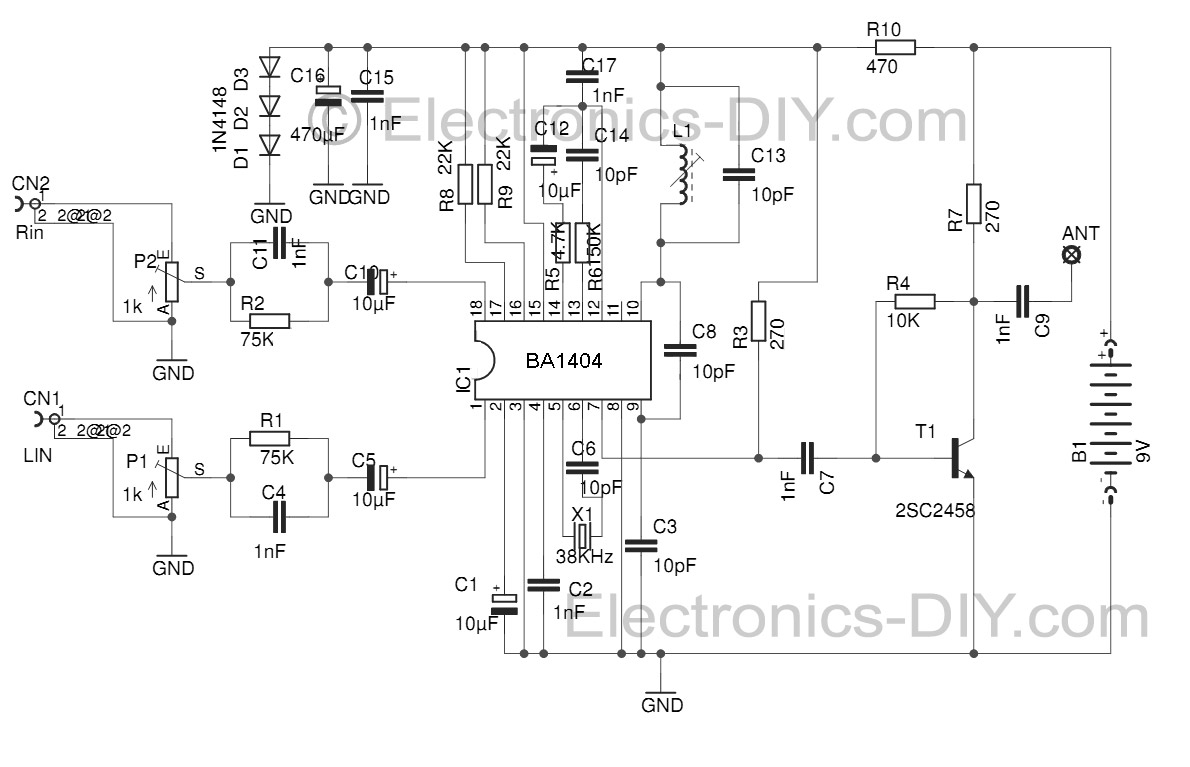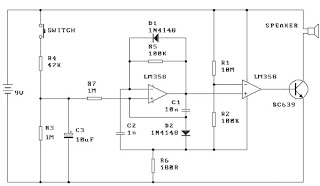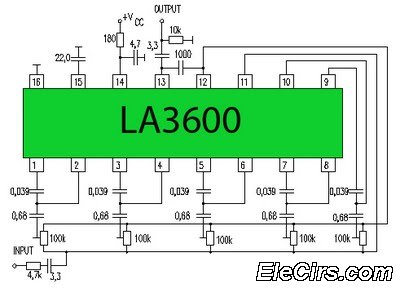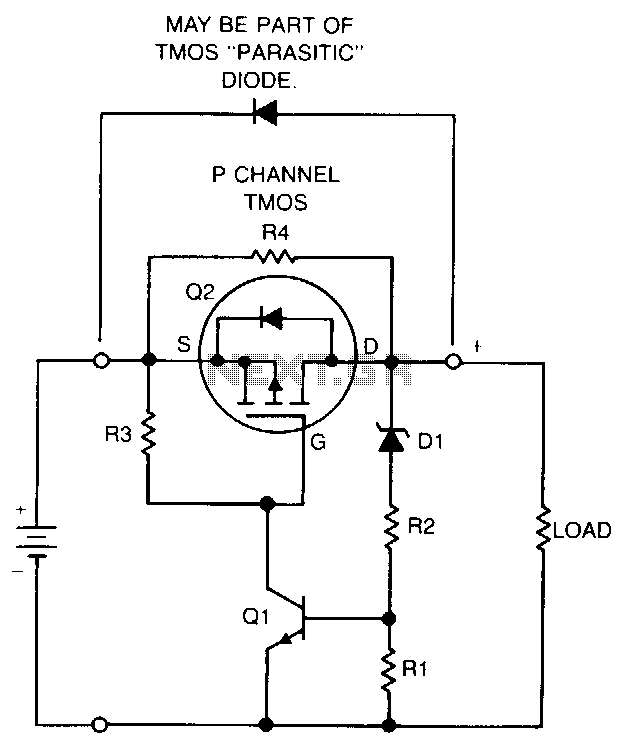
Eight multi-function lights synchronized chain of circuit SH803
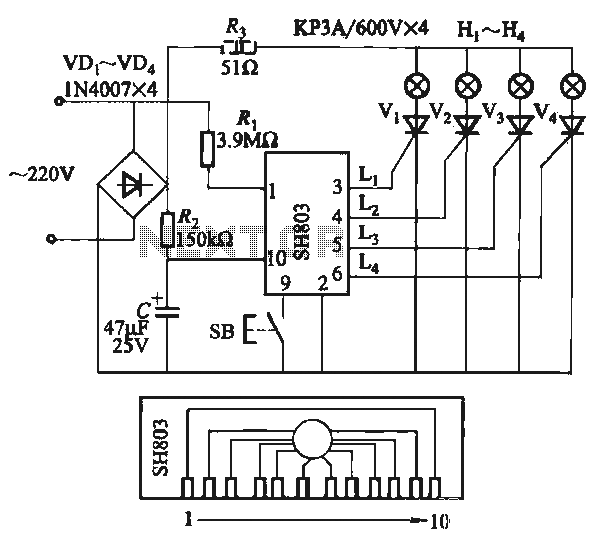
The circuit utilizes the SH803 flash IC, which can store eight different programs and offers various dimming options and light speed adjustments. A button is provided to trigger the control terminal SB on the 9-pin connector for program selection, ensuring ease of operation. The SH803 operates within a voltage range of 3 to 5V, with a typical value of 4.5V. It features eight distinct programs that can adjust the speed of light dimming, enabling effects such as cycling beats, rolling waves, chasing, blinking, slow fades, quick flashes, and a full brightness mode.
The SH803 flash IC is a versatile component designed for lighting applications, capable of generating a wide array of visual effects suitable for decorative or signaling purposes. The device's ability to store multiple programs allows for dynamic lighting sequences, enhancing the aesthetic appeal of installations.
The control mechanism involves a simple push-button interface connected to the 9-pin control terminal (SB), facilitating user interaction. Each press of the button cycles through the available programs, allowing users to select their desired lighting effect effortlessly. This feature is particularly beneficial in applications where user preference for lighting patterns may vary.
Operating within a voltage range of 3 to 5 volts, the SH803 is compatible with a variety of power sources, making it suitable for both battery-operated and mains-powered applications. The typical operating voltage of 4.5V ensures optimal performance while maintaining energy efficiency.
The eight programs include various lighting effects that can be categorized into dynamic and static patterns. Dynamic patterns may involve effects such as cycling beats, which create a rhythmic light display, and rolling waves that simulate the movement of light across a surface. Static patterns, on the other hand, may include modes like full brightness or slow fade, which provide a more stable lighting condition.
In summary, the SH803 flash IC circuit is a highly functional and user-friendly solution for creating diverse lighting effects, making it ideal for decorative lighting, stage performances, or any application where visual impact is essential. The combination of program selection, ease of operation, and a wide voltage range significantly enhances its versatility and usability in various electronic projects.It uses pattern SH803 flash IC, within reservoir eight kinds of programs and a variety of dimming, change the speed of light, a button to trigger a control terminal SB 9-pin to select a program, easy to operate. SH803 working voltage of 3 ~ 5V, the typical value 4.SV. There are eight ways and a variety of programs the speed of light becomes dimmer degree, can form a cycle beating, rolling waves, chasing, blinking, slowly fades, flashes quickly, all bright and so many flash effect.
The SH803 flash IC is a versatile component designed for lighting applications, capable of generating a wide array of visual effects suitable for decorative or signaling purposes. The device's ability to store multiple programs allows for dynamic lighting sequences, enhancing the aesthetic appeal of installations.
The control mechanism involves a simple push-button interface connected to the 9-pin control terminal (SB), facilitating user interaction. Each press of the button cycles through the available programs, allowing users to select their desired lighting effect effortlessly. This feature is particularly beneficial in applications where user preference for lighting patterns may vary.
Operating within a voltage range of 3 to 5 volts, the SH803 is compatible with a variety of power sources, making it suitable for both battery-operated and mains-powered applications. The typical operating voltage of 4.5V ensures optimal performance while maintaining energy efficiency.
The eight programs include various lighting effects that can be categorized into dynamic and static patterns. Dynamic patterns may involve effects such as cycling beats, which create a rhythmic light display, and rolling waves that simulate the movement of light across a surface. Static patterns, on the other hand, may include modes like full brightness or slow fade, which provide a more stable lighting condition.
In summary, the SH803 flash IC circuit is a highly functional and user-friendly solution for creating diverse lighting effects, making it ideal for decorative lighting, stage performances, or any application where visual impact is essential. The combination of program selection, ease of operation, and a wide voltage range significantly enhances its versatility and usability in various electronic projects.It uses pattern SH803 flash IC, within reservoir eight kinds of programs and a variety of dimming, change the speed of light, a button to trigger a control terminal SB 9-pin to select a program, easy to operate. SH803 working voltage of 3 ~ 5V, the typical value 4.SV. There are eight ways and a variety of programs the speed of light becomes dimmer degree, can form a cycle beating, rolling waves, chasing, blinking, slowly fades, flashes quickly, all bright and so many flash effect.
